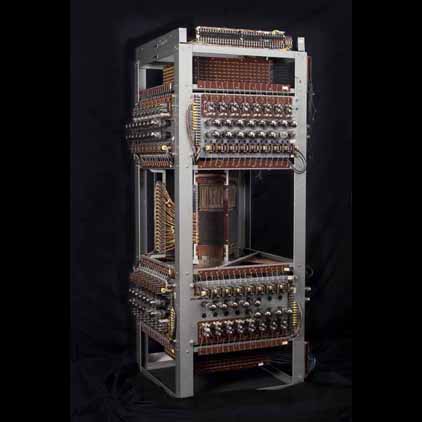Arguably the first large-scale and high-speed computer, the Whirlwind was developed by the MIT Servomechanisms
Laboratory in a project directed by
Jay Forrester
for the United States Navy. When the project started in 1944, it
was initially meant to design an aircraft simulator during World War II, but researchers soon realized that the
system was too slow and inaccurate. As a result of this, the simulation did not give a realistic enough feel for it
to be used as a proper training method for pilots. A key part of this project was the replacement of electrostatic
storage tubes with
magnetic core memory,
which allowed for high speeds and reliability, just not enough for the computer to function properly as a
universal flight simulator. Because of the use of the magnetic core memory, Whirlwind became a fully functioning
computer that had the potential to be
"utilized, together with other computing equipment at Technology, in a coordinated research and training program."
 Photo: MIT Cardinali for MIT Museum
Photo: MIT Cardinali for MIT Museum
The development of Whirlwind served as a milestone in the history of computation at MIT, but it all came at a steep
cost. The expected cost of the project was initially "$300,000 per annum" (the expected costs can be seen
here
), and it was projected to take approximately two years to finish. Although with any project there is always the
inevitability of going over budget and taking more time than expected, the Whirlwind Project went over the
projections far more than other computer projects of that time.
Starting in 1947, the Whirlwind Project received funding from the Office of Naval Research (ONR). A huge problem
with this project was the sheer amount of resources going into it. The research team consisted of more than one
hundred people, and the budget was close to $3 million (this is approximately equivalent to $32 million today).
This alone took up 20% of the ONR’s total research budget. As time progressed, more and more money was being
invested into this project, and the “ONR confidence in Project Whirlwind had reached its lowest point”
(Campbell-Kelly, Aspray, pg. 147). By the 1950s, critics thought that the extreme amount of money going into this
project was simply not worth the outcomes the team was producing.
Even MIT faculty members thought that Whirlwind was “too expensive” and “poorly designed.”
This led to the ONR cutting funds to the project. Project Whirlwind ended up taking a total of 8 years to develop,
and it ended up costing $8 million. Although the project stopped receiving funding in the early 1950s, Whirlwind
continued working as a digital computer until it was officially shut down on May 29, 1959.